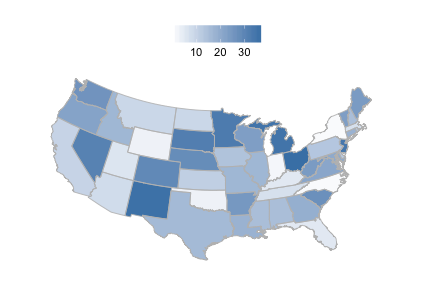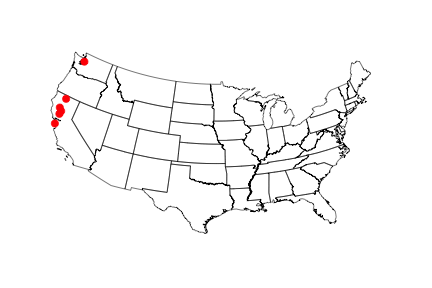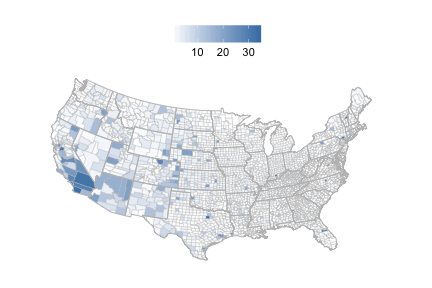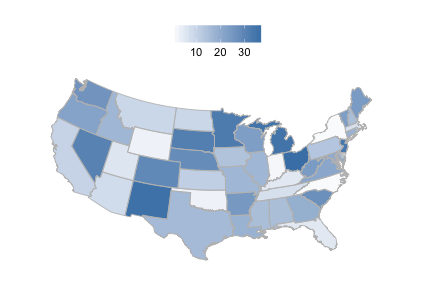rbison tutorial
for v0.5.4
rbison is an R package to search and retrieve data from the USGS BISON service. rbison wraps R code around the BISON API to allow you to talk to the BISON database from R.
BISON has occurrence data for the US only.
BISON is a node of the Global Biodiversity Information Facility (GBIF) - i.e., you can get data that’s available in BISON via GBIF instead if you want.
Info
See http://bison.usgs.ornl.gov/doc/api.jsp for API docs for the BISON API.
Installation
install.packages("rbison")
Or development version from GitHub
install.packages("devtools")
devtools::install_github("ropensci/rbison")
library("rbison")
Usage
Notice that the function bisonmap automagically selects the map extent to plot for you, being one of the contiguous lower 48 states, or the lower 48 plus AK and HI, or a global map. If some or all points outside the US, a global map is drawn, and throws a warning. You may want to make sure the occurrence lat/long coordinates are correct.
Get data
out <- bison(species = "Helianthus annuus", count = 10)
Inspect summary
out$summary
#> occurrences.legend.living occurrences.legend.observation
#> 1 6 746
#> occurrences.legend.centroid occurrences.legend.specimen
#> 1 1 3709
#> occurrences.legend.unknown living observation centroid specimen unknown
#> 1 1521 6 746 1 3709 1521
Map occurrences
head(out$counties)
#> record_id total county_name state
#> 1 39075 1 Holmes County Ohio
#> 2 42003 1 Allegheny County Pennsylvania
#> 3 40063 1 Hughes County Oklahoma
#> 4 39077 1 Huron County Ohio
#> 5 17043 2 DuPage County Illinois
#> 6 40067 2 Jefferson County Oklahoma
All points within the US (including AK and HI)
Get data
out <- bison(species="Bison bison", count=600)
#> Error: Bad Request (HTTP 400).
Inspect summary
out$summary
#> occurrences.legend.living occurrences.legend.observation
#> 1 6 746
#> occurrences.legend.centroid occurrences.legend.specimen
#> 1 1 3709
#> occurrences.legend.unknown living observation centroid specimen unknown
#> 1 1521 6 746 1 3709 1521
Map occurrences
bisonmap(out, tomap="state")

All points within the contiguous 48 states
Get data
out <- bison(species="Aquila chrysaetos", count=600)
#> Error: Bad Request (HTTP 400).
Inspect summary
out$summary
#> occurrences.legend.living occurrences.legend.observation
#> 1 6 746
#> occurrences.legend.centroid occurrences.legend.specimen
#> 1 1 3709
#> occurrences.legend.unknown living observation centroid specimen unknown
#> 1 1521 6 746 1 3709 1521
Map occurrences
bisonmap(out, tomap="points")

Plot county or state
With any data returned from a bison call, you can choose to plot county or state level data
Counties - using last data call for Aquila
bisonmap(out, tomap="county")

States - using last data call for Aquila
bisonmap(out, tomap="state")

Constrain search with county IDs or bounding boxes
Constrain search to a certain county.
Check out this site to get state and county fips codes. Fips codes are like so: First two digits are the state code - last three are the county code. For example the 06 in 06037 is the state of California, and the 037 is the Los Angeles county.
out <- bison(species="Helianthus annuus", countyFips = "06037")
Inspect summary
out$summary
#> occurrences.legend.living occurrences.legend.observation
#> 1 6 746
#> occurrences.legend.centroid occurrences.legend.specimen
#> 1 1 3709
#> occurrences.legend.unknown living observation centroid specimen unknown
#> 1 1521 6 746 1 3709 1521
By default, the query only returned 10 records
head(out$points)
#> name decimalLongitude decimalLatitude occurrenceID
#> 1 Helianthus annuus -122.3671 39.01127 1021808881
#> 2 Helianthus annuus -122.3308 47.60639 1258590900
#> 3 Helianthus annuus -122.3037 41.35260 1020858079
#> 4 Helianthus annuus -122.1928 38.82917 40886974
#> 5 Helianthus annuus -122.1692 37.42722 1022012170
#> 6 Helianthus annuus -122.1389 39.44917 1021150634
#> provider basis
#> 1 Consortium of California Herbaria Specimen
#> 2 Missouri Botanical Garden Specimen
#> 3 Consortium of California Herbaria Specimen
#> 4 US National Plant Germplasm System Unknown
#> 5 Consortium of California Herbaria Specimen
#> 6 Consortium of California Herbaria Specimen
#> common_name geo
#> 1 annual sunflower, sunflower, wild sunflower, common sunflower Yes
#> 2 annual sunflower, sunflower, wild sunflower, common sunflower Yes
#> 3 annual sunflower, sunflower, wild sunflower, common sunflower Yes
#> 4 annual sunflower, sunflower, wild sunflower, common sunflower Yes
#> 5 annual sunflower, sunflower, wild sunflower, common sunflower Yes
#> 6 annual sunflower, sunflower, wild sunflower, common sunflower Yes
Or specify county by its actual name - probably much easier.
out <- bison(species="Helianthus annuus", county = "Los Angeles")
Inspect summary
out$summary
#> occurrences.legend.observation occurrences.legend.centroid
#> 1 24 1
#> occurrences.legend.specimen occurrences.legend.unknown observation
#> 1 59 6 24
#> centroid specimen unknown
#> 1 1 59 6
By default, the query only returned 10 records
head(out$points)
#> name decimalLongitude decimalLatitude occurrenceID
#> 1 Helianthus annuus -118.7203 34.08030 1488148453
#> 2 Helianthus annuus -118.8517 34.79611 40886955
#> 3 Helianthus annuus -118.8517 34.79611 40886954
#> 4 Helianthus annuus -118.8286 34.12916 1132411638
#> 5 Helianthus annuus -118.8285 34.12966 1132402545
#> 6 Helianthus annuus -118.7944 34.70194 1021481336
#> provider basis
#> 1 BISON Observation
#> 2 US National Plant Germplasm System Unknown
#> 3 US National Plant Germplasm System Unknown
#> 4 iNaturalist.org Observation
#> 5 iNaturalist.org Observation
#> 6 Consortium of California Herbaria Specimen
#> common_name geo
#> 1 annual sunflower, sunflower, wild sunflower, common sunflower Yes
#> 2 annual sunflower, sunflower, wild sunflower, common sunflower Yes
#> 3 annual sunflower, sunflower, wild sunflower, common sunflower Yes
#> 4 annual sunflower, sunflower, wild sunflower, common sunflower Yes
#> 5 annual sunflower, sunflower, wild sunflower, common sunflower Yes
#> 6 annual sunflower, sunflower, wild sunflower, common sunflower Yes
bison will help you if you spell the name wrong, or use a partial name. The results are not printed below, but you would get a prompt asking you to pick between the two counties that start with Los.
bison(species="Helianthus annuus", county = "Los")
Constrain search to a amorphous area.
Check out the Wikipedia page here for an in depth look at the options, terminology, etc.
out <- bison(species="Helianthus annuus", aoi = "POLYGON((-111.06360117772908 38.84001566645886,-110.80542246679359 39.37707771107983,-110.20117441992392 39.17722368276862,-110.20666758398464 38.90844075244811,-110.63513438085685 38.67724220095734,-111.06360117772908 38.84001566645886))")
Inspect summary
out$summary
#> occurrences.legend.centroid occurrences.legend.specimen centroid
#> 1 1 1 1
#> specimen
#> 1 1
The data
out$points
#> name decimalLongitude decimalLatitude occurrenceID provider
#> 1 Helianthus annuus -110.7211 39.00903 1419799586 BISON
#> basis common_name
#> 1 Specimen annual sunflower, sunflower, wild sunflower, common sunflower
#> geo
#> 1 Yes
Constrain search to a certain aoibbox.
An aoibbox uses the format minx, miny, maxx, maxy.
out <- bison(species="Helianthus annuus", aoibbox = '-120.31,35.81,-110.57,40.21')
Inspect summary
out$summary
#> occurrences.legend.observation occurrences.legend.centroid
#> 1 43 1
#> occurrences.legend.specimen occurrences.legend.unknown observation
#> 1 92 72 43
#> centroid specimen unknown
#> 1 1 92 72
The data, by default, the query only returned 10 records
head(out$points)
#> name decimalLongitude decimalLatitude occurrenceID provider
#> 1 Helianthus annuus -113.7000 36.40001 1429539601 BISON
#> 2 Helianthus annuus -119.7417 36.94192 1493585452 BISON
#> 3 Helianthus annuus -111.4509 37.83162 1475891938 BISON
#> 4 Helianthus annuus -111.4509 37.83162 1475891939 BISON
#> 5 Helianthus annuus -111.7549 37.12521 1475815079 BISON
#> 6 Helianthus annuus -111.7549 37.12521 1475815080 BISON
#> basis
#> 1 Observation
#> 2 Observation
#> 3 Observation
#> 4 Observation
#> 5 Observation
#> 6 Observation
#> common_name geo
#> 1 annual sunflower, sunflower, wild sunflower, common sunflower Yes
#> 2 annual sunflower, sunflower, wild sunflower, common sunflower Yes
#> 3 annual sunflower, sunflower, wild sunflower, common sunflower Yes
#> 4 annual sunflower, sunflower, wild sunflower, common sunflower Yes
#> 5 annual sunflower, sunflower, wild sunflower, common sunflower Yes
#> 6 annual sunflower, sunflower, wild sunflower, common sunflower Yes
Citing
To cite rbison in publications use:
Scott Chamberlain (2017). rbison: Interface to the ‘USGS’ ‘BISON’ ‘API’. R package version 0.5.4. https://CRAN.R-project.org/package=rbison
License and bugs
- License: MIT
- Report bugs at our Github repo for rbison
